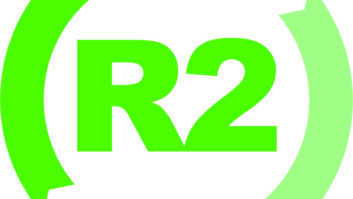Here’s what the new year is promising:
* Digital broadcasting standards for audio as well as video — and maybe (eventually) a $50 voucher to help consumers buy new hardware.
* “Cable-ready” TV sets, or probably just more squabbling about how to make cable and video equipment compatible.
* V-chips.
* Next-generation satellite services.
* Copyright enforcement.
* Antitrust probes of the software industry.
* Spectrum auctions for new video, paging and data delivery.
In other words, the 1996 electronics agenda in Washington looks remarkably similar to the year just past. Although the reform-minded 104th Congress rode into town last year vowing to reduce government interference in business activities, the climate hasn’t changed very much compared to the previous few years.
Admittedly, a few of the longest-pending issues — notably high-definition TV — are a step closer to resolution, although the legal fine-tuning will take a year or more. But other contentious situations continue to simmer: For example, cable TV compatibility with VCRs and consumer electronics devices continues to elude both industries, despite threats that the FCC will establish standards if the two sides cannot come to an agreement.On another front, the escalating howl about cyber-porn along the Internet is seeping elsewhere into the electronic environment, raising new calls for government crackdowns on racy material. Most observers think the proposals to control “indecent electronic communications” are unenforceable, but that hasn’t stopped Congress from pursuing such efforts.
Political frictions between the Republican Congress and Democratic administration make the electronics outlook even fuzzier. For instance, the telecommunications legislation has become a cauldron of unrelated issues. A pre-Christmas agreement seemed to guarantees enactment of the bill in 1995, but as we went to press that deal fell apart and now the bill’s future is again uncertain.
Some critics still contend that provisions such as the V-chip to censor TV violence and the set-top box compatibility feature should not be included in a law originally designed as a new blueprint for telephone and cable infrastructure. Add to this the brouhaha about spectrum auctions — a Clinton administration plan to generate billions of revenue dollars by selling airwaves to mobile communications, HDTV, and other transmission operators.
Auctions to date have been chaotic: In one case, nearly a quarter of the bidders defaulted. Critics of the approach say that in the case of HDTV, for example, the plan to make TV station operators buy spectrum for advanced TV services would slow down the implementation even more than is already the case. That’s why there is so much skepticism about a White House proposal to hand out $50 vouchers to help consumers buy digital TV converters. The plan would be funded by fees generated from the proposed HDTV digital spectrum auction. Broadcasters argue that consumers will have to spend $33 billion to $187 billion to replace or upgrade their current TV sets and video equipment. Many analysts agree that the government cannot cost-effectively create a fair and accurate voucher distribution plan.
Moving To A Digital World
Undoubtedly, the biggest issue is the move to an all-digital broadcasting environment. The FCC is now considering the Grand Alliance recommendations of its Advisory Committee on Advanced Television Service. What began eight years ago as a deliberation over HDTV standards has turned into a plan for converting America’s (and hence the world’s) broadcast formats into digital systems.
Along the way, the advisory panel introduced the possibility of “standard definition TV” (SDTV), a digital system that would let broadcast stations transmit high-quality images and still have room left over for data transmission and other non-broadcast services. Gone in the process is the widescreen video format, although a variety of new equipment and technology options would be available.
Immediately after accepting the HDTV recommendations, the Commission launched a digital TV rule-making that is likely to be deliberated for a year or more. Meanwhile, some satellite and cable TV operators — which are not bound by the advanced TV proposal, although they have been cooperating during the testing and rule-making process — are eyeing opportunities to develop their own high-definition systems. Separately, the FCC is starting its fifth year of deliberations into Digital Audio Radio (DAR) and has four proposals for a standard. No deadline has been established for final DAR rules.
Cable Compatibility Standoff
The elusive quest for a truce between electronics makers who want to sell cable-ready video equipment and the cable industry continues to simmer. Industry conferees are near agreement, but several big sticking points remain. Adding a complication is a proposal by Rep. Anna Eschoo (D-Calif.) that would prevent FCC’s establishing the needed compatibility standard to protect the future of a home automation system developed by her constituent Echelon.
Senate-House conferees agreed to require a V-chip that lets parents block objectionable programming into all 13″-&-over TVs. House Telecommunications Subcommittee chairman Jack Fields (R-Texas), says he will seek a court ruling on the constitutionality of such a law. But in the grand scheme of Washington affairs, the pending factors touched on issues that also affect the electronics industry. Various industry-related antitrust issues also are simmering, including the Justice Department’s concern with Microsoft’s control over the computer software industry. Concern with media concentration may prompt a federal probe of the proposed Time Warner acquisition of Turner Broadcasting. Such long-standing issues as copyright protection and trademarks continue to pop up, with the focus now on digital technology and the Internet, and bureaucrats are trying to redefine rules covering use of the “Made in USA” label.
The success of direct-broadcasting satellite services keeps attracting new entrants, and six applicants are now seeking FCC permission to use the 13 additional satellite slots to be created in the C-band and Ku-band segments. With all the policy-making still to come, 1996 appears to be shaping up as a good year for lawyers and lobbyists.
U.S. Economy Chugging Ahead Into New Year
By Don Hogsett
Cooling off somewhat from surprising strength earlier this year, the U.S. economy is expected to chug ahead at a moderate pace during the next two years, with inflation held in check and interest rates holding at reassuringly low levels, according to a team of economists at the University of Michigan in Ann Arbor, Mich. Polishing up their crystal ball, the U-M economists project modest growth in real Gross Domestic Product of 2.6% in 1996 and “a bit more in 1997” as House and Senate Republicans continue to dominate federal budget planning over the next few years. Under that scenario, with growth holding steady, if not robust, the economists say they expect “little change in the unemployment rate, and subdued inflation.” And a tightening federal budget over the next few years, they think, will be “enough to take to about zero the chances that the Fed will feel like raising interest rates any time soon.”
Among the highlights of the U-M economic outlook for 1996:
* Inflation will remain “distinctly moderate.” Following a 2.2% increase in 1995, consumer prices will rise by about 2.1% in 1996 before climbing at a pace of 2.9% in 1997.
* Core industrial prices will follow a similarly moderate course. After inching up at an extraordinarily low pace of 1.3% in 1995, prices will rise by just 1.6% in 1996 and then climb by 2.5% in 1997.
* The unemployment rate is projected to average 5.6% in 1996 and 5.5% in 1997, virtually unchanged from 1995.
* Disposable personal income will grow at a sluggish pace of 3% in 1996 and by an even smaller 2.4% in 1997, partly held in check by low rates of inflation and industrial prices.
* Corporate profits, which rose above 8% of GDP in 1994 — the first time since 1979 — are expected to hold at 8.1% of GDP in 1996 and 1997. Those profit levels are “just slightly under the 8.3% we now estimate for 1995 and are still strong by recent standards.”
* The federal deficit is forecast to slip to 2% of GDP in 1996 and to edge down to 1.9% in 1997. More substantial improvement is expected in 1998 and beyond, said the U-M team, as tax cuts click in and government spending cuts help produce a balanced budget by 2002.
* Interest rates are expected to hold steady, with both long and short rates drifting up only slightly from current levels. The three-month T-bill rate is expected to average 5.4% in both 1996 and 1997, while conventional mortgage rates average 7.4% in 1996 and 7.6% in 1997.
* Housing starts are expected to fall off slightly, dipping to 1.33 million in 1996 and 1.31 million in 1997, “just slightly less than the 1.36 million starts we now project for 1995.”
* And light vehicle sales are projected to rise a bit in each year of the forecast. “Light truck sales, which we now project will total 5.75 million units in 1995, are forecast to climb to 6 million units in 1996 and to improve further to 6.2 million units in 1997,” the study says. The study adds that “when steady car sales of 8.9 to 9 million units are added in, light vehicle sales are forecast to total 14.9 million units in 1996 and 15.1 million units in 1997,” up from 14.7 million in 1995.
Don Hogsett is group business editor for the Cahners Publishing Business Newspaper Group of which TWICE is a member.
CE Unit Cuts Nokia’s Net
Nokia of Finland said it expects to report significantly lower earnings for the final four months of the year as a result of a sharp loss at its European consumer electronics business and a sub par performance from its mobile phone business. Nokia said the downturn at the Nokia Mobile Phones unit came “despite improvements in the U.S. mobile phone business.” In a telephone interview, CEO Jorma Ollila said that component shortages and “occasional growing pains in terms of logistics” were the cause of the problems with the phone market.
Nokia believes the phone market still has great potential, Ollia said. He looks for 1996 to have “continued growth in the 30% to 45% range in sales of telecommunications systems and mobile,” and said there is “no reason to change our estimate of 350 million cellular subscribers in the world in year 2000.” Ollia blamed the loss in consumer electronics on a sluggish European market for color TV — Nokia is Europe’s third largest domestic CE marketer, with annual sales of about $700 million — and said the unit was being reorganized. Excluding possible restructuring charges, he expects Nokia’s overall electronics business to be profitable for full 1995.













